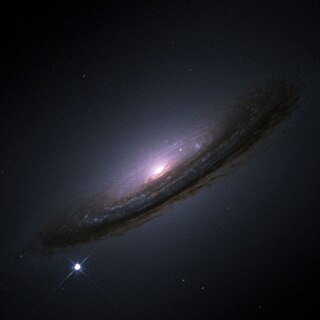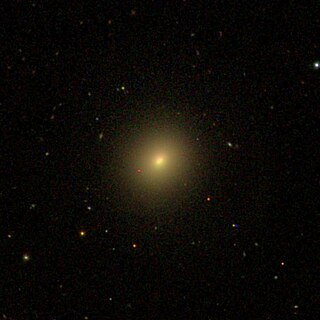
Messier 59 or M59, also known as NGC 4621, is an elliptical galaxy in the equatorial constellation of Virgo. It is a member of the Virgo Cluster, with the nearest fellow member 8′ away and around 5 magnitudes fainter. The nearest cluster member of comparable brightness is the lenticular galaxy NGC 4638, which is around 17′ away. It and the angularly nearby elliptical galaxy Messier 60 were both discovered by Johann Gottfried Koehler in April 1779 when observing comet seeming close by. Charles Messier listed both in the Messier Catalogue about three days after Koehler's discovery.

NGC 2787 is a barred lenticular galaxy approximately 24 million light-years away in the northern constellation of Ursa Major. It was discovered on December 3, 1788 by German-born astronomer William Herschel. J. L. E. Dreyer described it as, "bright, pretty large, a little extended 90°, much brighter middle, mottled but not resolved, very small (faint) star involved to the southeast". The visible galaxy has an angular size of 2.5 × 1.5 arcminutes or 3.24 × 1.81 arcminutes and an apparent visual magnitude of 11.8.

NGC 4526 is a lenticular galaxy with an embedded dusty disc, located approximately 55 million light-years from the Solar System in the Virgo constellation and discovered on 13 April 1784 by William Herschel.

NGC 5548 is a Type I Seyfert galaxy with a bright, active nucleus. This activity is caused by matter flowing onto a 65 million solar mass (M☉) supermassive black hole at the core. Morphologically, this is an unbarred lenticular galaxy with tightly-wound spiral arms, while shell and tidal tail features suggest that it has undergone a cosmologically-recent merger or interaction event. NGC 5548 is approximately 245 million light years away and appears in the constellation Boötes. The apparent visual magnitude of NGC 5548 is approximately 13.3 in the V band.

NGC 1409 is a quiescent lenticular galaxy in the equatorial constellation of Taurus. It was discovered by the German-born astronomer William Herschel on January 6, 1785. NGC 1409 is located in close proximity to the smaller Seyfert galaxy NGC 1410, and the two are strongly interacting. Their respective nuclei have a separation of just 23 kly, and they share a diffuse stellar envelope with a radius extending out to 49 kly.

NGC 3593 is a lenticular galaxy located in the constellation Leo. It has a morphological classification of SA(s)0/a, which indicates it is a lenticular galaxy of the pure spiral type. Despite this, it has a large amount of hydrogen, both in its molecular and atomic (H) form. It is a starburst galaxy, which means it is forming new stars at a high rate. This is occurring in a band of gas surrounding the central nucleus. There is a single arm, which spirals outward from this ring. It is frequently but not consistently identified as a member of the Leo Triplet group.

NGC 89 is a barred spiral or lenticular galaxy, part of Robert's Quartet, a group of four interacting galaxies.

"Legacy Survey Sky Browser". www.legacysurvey.org. Retrieved 2023-05-19.

NGC 113 is an unbarred lenticular galaxy located in the constellation Cetus. It was discovered by German astronomer, Ernst Wilhelm Leberecht Tempel, on August 27, 1876.

NGC 4036 is the New General Catalogue identifier for a lenticular galaxy in the northern circumpolar constellation of Ursa Major. In the Carnegie Atlas of Galaxies, it is described as being "characterized by an irregular pattern of dust lanes threaded through the disc in an 'embryonic' spiral pattern indicating a mixed S0/Sa form." It is located near the Big Dipper, a little to the north of the mid-way point between the stars Alpha Ursae Majoris and Delta Ursae Majoris. With a visual magnitude of 10.7, it can be dimly viewed using a 4 in (10 cm) aperture telescope.

NGC 4138 is the New General Catalogue identifier for a lenticular galaxy in the northern constellation of Canes Venatici. Located around 52 million light years from Earth, it spans some 2.1 × 1.3 arc minutes and has an apparent visual magnitude of 11.3. The morphological classification of NGC 4138 is SA0+(r), indicating it lacks a bar formation and has tightly wound spiral arms with a ring-like structure around the nucleus. It has no nearby companion galaxies.

NGC 1326 is a lenticular galaxy in the constellation Fornax, 63 million light-years away. It was discovered by English astronomer John Herschel on 29 November 1837. It is a member of the Fornax Cluster, an NGC 1316 subgroup and has a diameter of 70 000 light-years.

NGC 560 is a lenticular galaxy in the constellation Cetus. It is estimated to be about 250 million light-years from the Milky Way and has a diameter of approximately 150,000 light years. It is part of the Abell 194 galaxy cluster. NGC 560 was discovered on October 1, 1785 by the German-British astronomer William Herschel.

NGC 670 is a lenticular galaxy located in the Triangulum constellation about 165 million light years from the Milky Way. It was discovered by the German-British astronomer William Herschel in 1786.

NGC 850 is a lenticular galaxy in the constellation Cetus. It is estimated to be 300 million light-years from the Milky Way and has a diameter of approximately 130,000 ly.

NGC 790 is a lenticular galaxy in the constellation Cetus. It is estimated to be 233 million light-years from the Milky Way and has a diameter of approximately 90,000 light years. NGC 790 was discovered on September 10, 1785 by the German-British astronomer William Herschel.

NGC 939 is a lenticular or elliptical galaxy in the constellation Eridanus. It is estimated to be 241 million light-years from the Milky Way and has a diameter of approximately 80,000 ly. NGC 939 was discovered on October 18, 1835 by astronomer John Herschel.

NGC 3945 is a barred lenticular galaxy in the constellation Ursa Major. It was discovered on March 19, 1790, by the astronomer William Herschel.

NGC 3414 is a lenticular galaxy in the constellation Leo Minor. It was discovered by William Herschel on April 11, 1785. It is the central galaxy of a rich galaxy group. Two galaxies, NGC 3418 and UGC 5958, have similar redshifts and are within 800,000 light-years of NGC 3414. It is a member of the NGC 3504 Group of galaxies, which is a member of the Leo II Groups, a series of galaxies and galaxy clusters strung out from the right edge of the Virgo Supercluster.

NGC 3619 is an unbarred lenticular galaxy located in the constellation Ursa Major. It was discovered by the astronomer William Herschel on March 18, 1790.




















